外研版必修3 Module 1 Europe Grammar2 Subject and verb agreement课件(共32张PPT)
文档属性
| 名称 | 外研版必修3 Module 1 Europe Grammar2 Subject and verb agreement课件(共32张PPT) | 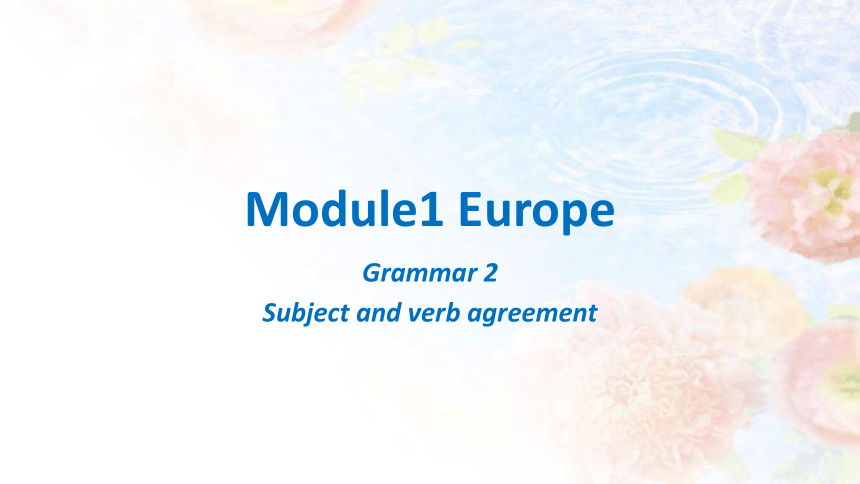 | |
| 格式 | zip | ||
| 文件大小 | 426.0KB | ||
| 资源类型 | 教案 | ||
| 版本资源 | 外研版 | ||
| 科目 | 英语 | ||
| 更新时间 | 2020-04-24 10:30:34 | ||
图片预览


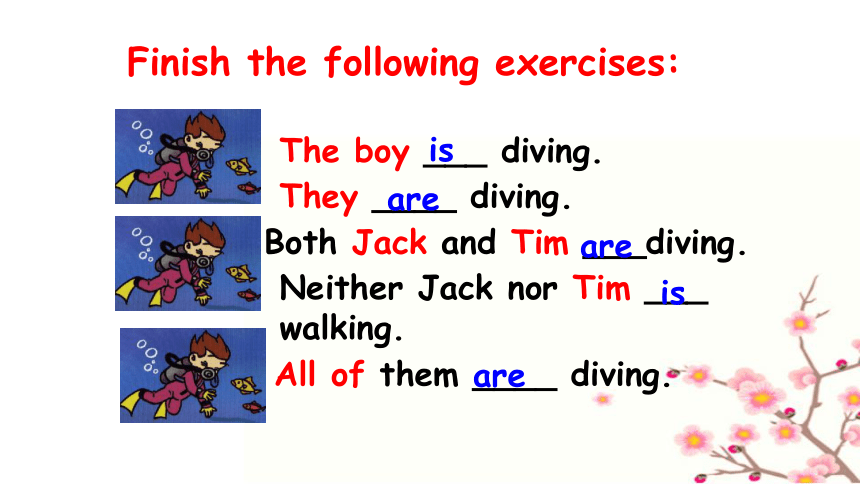



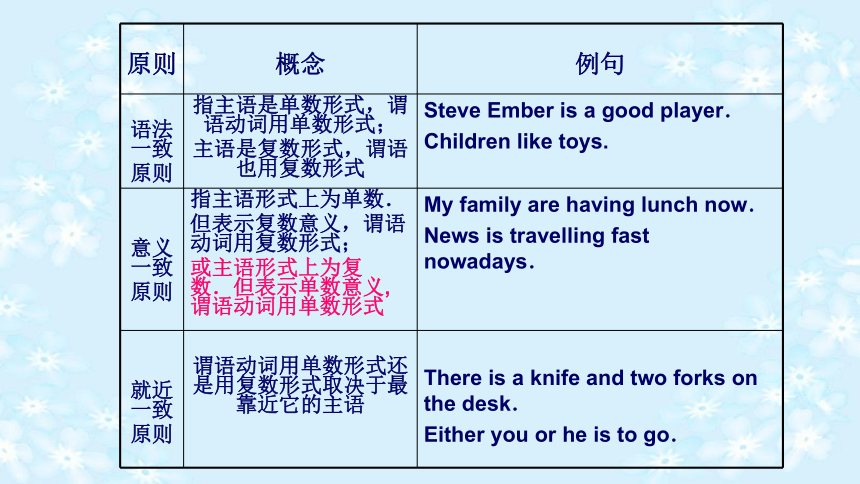

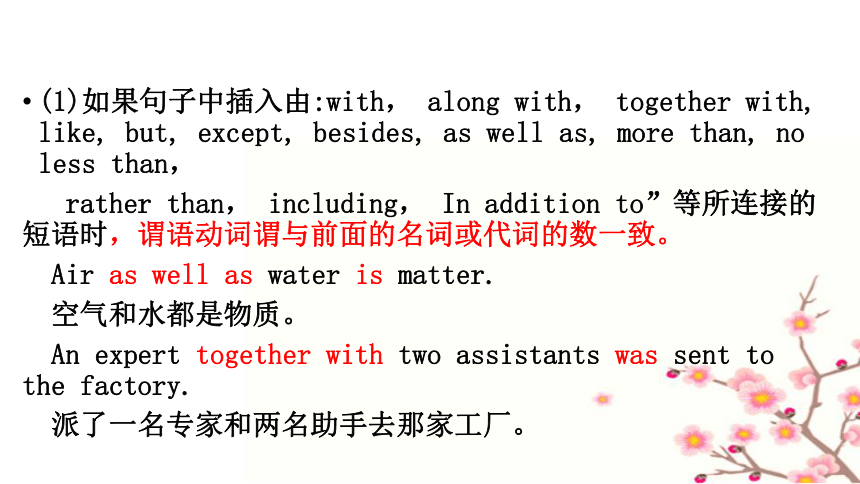
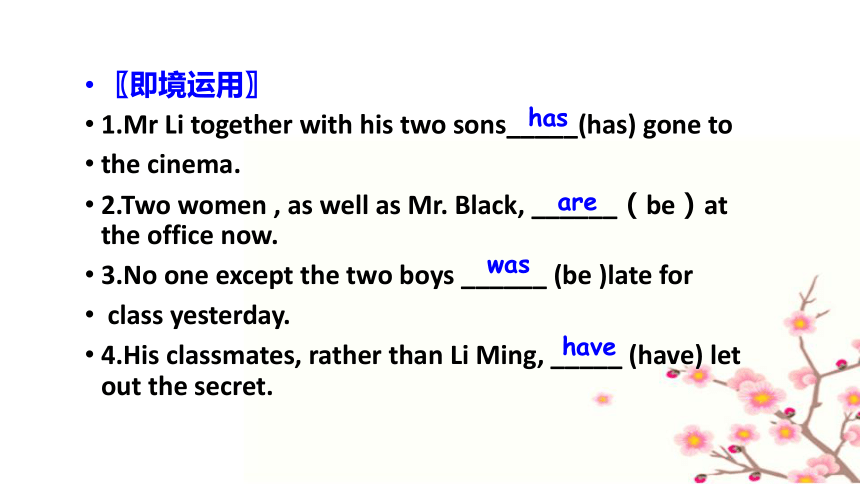
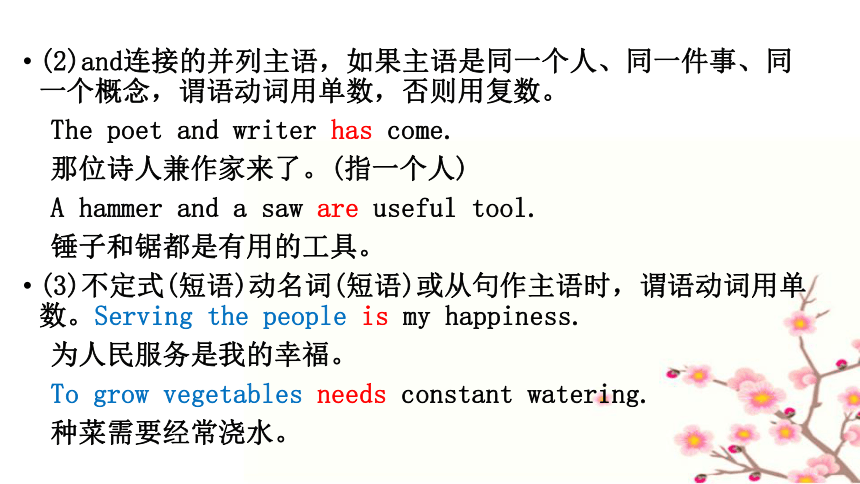

文档简介
课件32张PPT。Module1 EuropeGrammar 2
Subject and verb agreementLearning Aims: Students will
1.correct some mistakes on learning papers.
2. try to grasp the rules of subject-verb agreement by challenging their memory.
3. develop the ability to put the grammar rules into practice.
The boy ___ diving.They ____ diving.Both Jack and Tim ___diving.All of them ____ diving.Neither Jack nor Tim ___ walking.isareareisareFinish the following exercises:Bob _____ a worker.isMike and Bob _____ workers.areBoth Mike and Bob ____
workers.areNeither Mike nor Bob ___a teacher.isNeither of them ________
(know) how to teach English. knows/knowAll of them ______ workers.None of them ___________
(know) how to teach English.are knows/know主谓一致:在英语学习中,随着学习的深入,同学们会不断发现能充当主语的成分也越来越多,除了常见的名词,代词,还有非谓语,句子等等,如何使这些主语和他的谓语动词保持一致,数上的一致,即谓语一致,是我们学习的重要问题。一、主谓一致的定义语法详解:
所谓主谓一致是指主语和谓语动词之间,即主语的____和___决定着谓语动词对应的形式。人称数但是如果主语不是单一的,或主语名词的数比较特殊时,其主谓一致一般要根据 、 、 .语法一致意义一致就近原则当发生冲突时,意义原则为优先考虑的原则。二、主谓一致的三个原则1.语法一致
主语和谓语在语法形式上要一致。
就是主语为单数形式, 谓语即用单数形式; 主语为复数形式, 谓语也用复数形式。如:
The book is very interesting.
这本书很有趣。
The books are very interesting.
这些书很有趣。(1)如果句子中插入由:with, along with, together with, like, but, except, besides, as well as, more than, no less than,
rather than, including, In addition to”等所连接的短语时,谓语动词谓与前面的名词或代词的数一致。
Air as well as water is matter.
空气和水都是物质。
An expert together with two assistants was sent to the factory.
派了一名专家和两名助手去那家工厂。
〖即境运用〗
1.Mr Li together with his two sons_____(has) gone to
the cinema.
2.Two women , as well as Mr. Black, ______(be)at the office now.
3.No one except the two boys ______ (be )late for
class yesterday.
4.His classmates, rather than Li Ming, _____ (have) let out the secret. hasarewashave(2)and连接的并列主语,如果主语是同一个人、同一件事、同一个概念,谓语动词用单数,否则用复数。
The poet and writer has come.
那位诗人兼作家来了。(指一个人)
A hammer and a saw are useful tool.
锤子和锯都是有用的工具。
(3)不定式(短语)动名词(短语)或从句作主语时,谓语动词用单数。Serving the people is my happiness.
为人民服务是我的幸福。
To grow vegetables needs constant watering.
种菜需要经常浇水。
What he said sounds reasonable.
他说的话听起来有道理。
注意:
what 引导主语从句时,主句的谓语动词一般用 若从句的谓语动词是复数形式或从句的表语是复数形式时,主句的谓语动词通常用复数形式。
What are needed are rational and firm actions.
需要的是理智而果敢的行为。
What we need are more volunteers.
我们所需要的是更多的志愿者。单数形式;(4)and连接的并列主语由each, every或no修饰时,谓语动词用单数。
Every boy and every girl has been invited to the party.
每个男孩和女孩都已经被邀请参加聚会了。
(5)主语是“复数代词+each”时,谓语动词用复数。
We each have something to say.( Each of us has something to say.)
我们每个人都有些话要说。
(6)none作主语时,谓语动词可用单数,也可用复数;但在代表不可数的事物时总是被看作单数,因而谓语动词要用单数。
None of us are/is perfect. 人无完人。
None of this worries me.这事一点儿也不让我担心。 (7) 不定代词作主语, 谓语动词要用______,如each, either, one, someone ,somebody, something, anybody, anyone, anything, everybody, everyone, everything, nobody, no one, nothing。
注意:none of 和 neither/either of加复数名词做主语时,谓动可用单数,也可用复数。单数
〖即境运用〗
1.Someone_____ asking for you.(be) 2.Nothing _____ found in the room.( be )
3.(1)Neither of them _____(know) how to teach English.他们两个全都不知道如何教英语。
(2)Neither of them _____(know) how to teach English.他们两个没有一个知道如何教英语
4.(1)None of them _____(has)been to the Great Wall.他们中没有一个人去过长城。
(2)None of them _____(has)been to the Great Wall.他们全都没有一个人去过长城isisknowknowshashave(8) all of; a lot of; lots of; some of; most of; plenty of; the rest of; half of; part of; majority of; percent of; one third of等量词加名词作主语的时候,谓语动词与of后面的名词保持一致。
〖即境运用〗
1.All of my classmates ____(like) music.
2.All of the water ___(be ) gone.
3.About 60 percent of the students in our school ___(be)boyslikeisare(9)名词 trousers, scissors, clothes, goods, glasses等作主语时,谓语动词要用复数。
My trousers are new.
我的裤子是新的。
The scissors are sharp.
这把剪刀很锋利。
Her clothes are nice.
她的衣服很漂亮。
(10)形复意单的名词,如news,以ics结尾的学科名称如
physics, mathematics,国名如 the United States,报纸名如The New York Times以及 the United Nations(联合国)等作主语时,谓语动词要用单数。
注意: advice, physics, news, furniture, information,fun, weather, progress等没有复数形式。
(11)“ the number of+名词”作主语时,谓语动词要用单数。
The number of deer, mountain lions and wild roses does not change much if people leave things as they are.
如果人们任其自然发展,鹿、美洲狮和野玫瑰的数量不会有很大变化。(12) many a(许多)和 more than one(不止一个)等作定语,修饰单数可数名词作主语时,尽管从意义上看是复数,谓语动词用单数。
Many a way has been tried.
已经试过许多办法了。
More than one person is against the proposal.
不止一个人反对这个提议。
(13)“百分数(或分数)+of+单数可数名词(或不可数名词)”作主语时,谓语动词用单数;“百分数(或分数)+of+复数名词”作主语时,谓语动词用复数。如果后面的名词是population,则谓语动词用单复数形式都可。
Twenty per cent of the workers in the factory are women.
这个工厂里百分之二十的工人是女性。
Altogether more than 70 per cent of the surface of our planet is covered by water.
总的来说,我们这个行星的表面有百分之七十以上是被水覆盖的。
Sixty-five per cent of the population of the town live/lives in the suburbs.
这个镇百分之六十五的人口居住在郊区。(14) 定语从句的关系代词who, which, that在从句中作主语时,要与先行词的人称和数保持一致。
1.Those who______ singing may join us.喜欢唱歌的人可以加入我们。
2.Tom, who ___ your friend, should help you.你的朋友汤姆应该帮助你。 enjoyis(15) 在主谓倒装的句子中,谓语动词的数应与其后的名词或代词一致。
〖即境运用〗
1.Between the two windows ______(hang) two pictures.
2.Between the two rows of trees ________(stand) the teaching building. hangstands(16) a large quantity of + 名单 + 谓单
名复 + 谓复/单
large quantities of + 名单/复 + 谓复werewerewas(17). a (large )amount of, 修饰不可数名词, 其短语作主语时, 谓语动词用单数; (large )amounts of 修饰不可数名词, 其短语作主语时, 谓语动词通常用复数。〖即境运用〗
1.A large amount of money _____ spent on books.(be)
2. Large amounts of money _____ spent on books.(be)waswere(18)one and a half +可数名词复数 做主语,谓语动词
常用复数形式。
One and a half apples were left on the table.
一个半苹果被剩在了桌子上。2、意义一致原则 所谓意义一致原则是指谓语动词和主语一致不是取决于主语的语法形式, 而是其实际意义。有的主语名词在形式上是单数, 但在意义上却是复数;有的主语名词在形式上是复数, 但在意义上却是单数。
如:Cattle eat grass. 牛吃草。
The police were called in. 警察被召来了。(1)不定代词 all, most,some等作主语时,谓语动词的单
复数取决于它们所指代的名词的数。
Most of the apples were rotten.
大部分苹果是腐烂的。
Most of the apple was eaten by a rat.
这个苹果的大部分被一只老鼠吃掉了。
(2)“the+形容词(或分词)”指一类人,如 the rich(富人), the living(活着的人)。这类词作主语时,谓语动词用复数。
The sick have been cured and the lost have been found.
病人已经被治愈,失踪的人已经被找到。(3)用and连接的成对名词习惯上被看成是一个整体,如
bread and butter(黄油面包片), knife and fork(刀叉)等作主
语时,谓语动词用单数。
Whisky and soda is always his favourite drink.
威士忌酒加苏打水总是他最喜爱的饮料。
(4)不定数量的词组,如 part of, a lot of, lots of, plenty
of等作主语时,谓语动词的单复数取决于其后面名词的数。
A part of the textbooks have arrived.
部分教科书已运到。
Part of the building was destroyed in the fire.
大楼的一部分毁于火灾。(5)表示时间、金钱、距离、度量等的名词作主语,尽管是复数形式,
但它们作为一个单一的概念时,其谓语动词用单数形式。
Ten miles is a good distance.十英里是个不短的距离。
(6)有些集合名词,如 public, family, audience, class,population,
company, group, government等作主语时既可表示单数,又
可表示复数。若其强调一个整体,谓语动词用单数;若强调整
体中的个体,则谓语动词用复数。有少数集合名词本身表示复
数含义,如 people, cattle和 police,它们作主语时,谓语动词
要用复数。
My family is a large one.
我家是个大家庭。
My family are all music lovers.
我家每一个人都是音乐爱好者。(7)主语是单复数同形的名词时,如 works,shee
means,deer等,谓语动词用单数还是复数要根据句意决定。
Each possible means has been tried.
每一种可能的方法都已经被试过了。
All possible means have been tried.
所有可能的方法都已经被试过了。
(8)all,none,some,any等不定代词做主语时,谓语动词的数根据
其指代的内容而定。
All are here and all is ready.
所有的人都已到,一切就绪。(9)all/most/half/the rest of +名词 或分数/百分数+of+名词/
代词做主语时,若名词/代词表示单数概念或抽象,谓语动词用
单数形式;若表示复数概念,谓语动词用复数形式。
The rest of the book is very interesting.
这本书剩余的部分很有趣。
Most of his time is spent on study.
他大部分时间用在了学习上。
Twenty percent of the workers here are women.
这儿20%的工人是女工。三、就近一致原则
就近一致原则也称邻近原则,即谓语与靠近它的名词、代词(有时不一定是主语)在人称和数上一致。
就近一致现象一般出现在 there be句型中,以及由
neither…nor, either……or,not….but, not only… but also,whether……or,或or连接并列主语的句子中。
What he does or what he says does not concern me.
他所做的或所说的都与我无关。
Neither you nor I am wrong.
你和我都没有错。Homework
1.Review the grammar
2.Finish the paper.
Subject and verb agreementLearning Aims: Students will
1.correct some mistakes on learning papers.
2. try to grasp the rules of subject-verb agreement by challenging their memory.
3. develop the ability to put the grammar rules into practice.
The boy ___ diving.They ____ diving.Both Jack and Tim ___diving.All of them ____ diving.Neither Jack nor Tim ___ walking.isareareisareFinish the following exercises:Bob _____ a worker.isMike and Bob _____ workers.areBoth Mike and Bob ____
workers.areNeither Mike nor Bob ___a teacher.isNeither of them ________
(know) how to teach English. knows/knowAll of them ______ workers.None of them ___________
(know) how to teach English.are knows/know主谓一致:在英语学习中,随着学习的深入,同学们会不断发现能充当主语的成分也越来越多,除了常见的名词,代词,还有非谓语,句子等等,如何使这些主语和他的谓语动词保持一致,数上的一致,即谓语一致,是我们学习的重要问题。一、主谓一致的定义语法详解:
所谓主谓一致是指主语和谓语动词之间,即主语的____和___决定着谓语动词对应的形式。人称数但是如果主语不是单一的,或主语名词的数比较特殊时,其主谓一致一般要根据 、 、 .语法一致意义一致就近原则当发生冲突时,意义原则为优先考虑的原则。二、主谓一致的三个原则1.语法一致
主语和谓语在语法形式上要一致。
就是主语为单数形式, 谓语即用单数形式; 主语为复数形式, 谓语也用复数形式。如:
The book is very interesting.
这本书很有趣。
The books are very interesting.
这些书很有趣。(1)如果句子中插入由:with, along with, together with, like, but, except, besides, as well as, more than, no less than,
rather than, including, In addition to”等所连接的短语时,谓语动词谓与前面的名词或代词的数一致。
Air as well as water is matter.
空气和水都是物质。
An expert together with two assistants was sent to the factory.
派了一名专家和两名助手去那家工厂。
〖即境运用〗
1.Mr Li together with his two sons_____(has) gone to
the cinema.
2.Two women , as well as Mr. Black, ______(be)at the office now.
3.No one except the two boys ______ (be )late for
class yesterday.
4.His classmates, rather than Li Ming, _____ (have) let out the secret. hasarewashave(2)and连接的并列主语,如果主语是同一个人、同一件事、同一个概念,谓语动词用单数,否则用复数。
The poet and writer has come.
那位诗人兼作家来了。(指一个人)
A hammer and a saw are useful tool.
锤子和锯都是有用的工具。
(3)不定式(短语)动名词(短语)或从句作主语时,谓语动词用单数。Serving the people is my happiness.
为人民服务是我的幸福。
To grow vegetables needs constant watering.
种菜需要经常浇水。
What he said sounds reasonable.
他说的话听起来有道理。
注意:
what 引导主语从句时,主句的谓语动词一般用 若从句的谓语动词是复数形式或从句的表语是复数形式时,主句的谓语动词通常用复数形式。
What are needed are rational and firm actions.
需要的是理智而果敢的行为。
What we need are more volunteers.
我们所需要的是更多的志愿者。单数形式;(4)and连接的并列主语由each, every或no修饰时,谓语动词用单数。
Every boy and every girl has been invited to the party.
每个男孩和女孩都已经被邀请参加聚会了。
(5)主语是“复数代词+each”时,谓语动词用复数。
We each have something to say.( Each of us has something to say.)
我们每个人都有些话要说。
(6)none作主语时,谓语动词可用单数,也可用复数;但在代表不可数的事物时总是被看作单数,因而谓语动词要用单数。
None of us are/is perfect. 人无完人。
None of this worries me.这事一点儿也不让我担心。 (7) 不定代词作主语, 谓语动词要用______,如each, either, one, someone ,somebody, something, anybody, anyone, anything, everybody, everyone, everything, nobody, no one, nothing。
注意:none of 和 neither/either of加复数名词做主语时,谓动可用单数,也可用复数。单数
〖即境运用〗
1.Someone_____ asking for you.(be) 2.Nothing _____ found in the room.( be )
3.(1)Neither of them _____(know) how to teach English.他们两个全都不知道如何教英语。
(2)Neither of them _____(know) how to teach English.他们两个没有一个知道如何教英语
4.(1)None of them _____(has)been to the Great Wall.他们中没有一个人去过长城。
(2)None of them _____(has)been to the Great Wall.他们全都没有一个人去过长城isisknowknowshashave(8) all of; a lot of; lots of; some of; most of; plenty of; the rest of; half of; part of; majority of; percent of; one third of等量词加名词作主语的时候,谓语动词与of后面的名词保持一致。
〖即境运用〗
1.All of my classmates ____(like) music.
2.All of the water ___(be ) gone.
3.About 60 percent of the students in our school ___(be)boyslikeisare(9)名词 trousers, scissors, clothes, goods, glasses等作主语时,谓语动词要用复数。
My trousers are new.
我的裤子是新的。
The scissors are sharp.
这把剪刀很锋利。
Her clothes are nice.
她的衣服很漂亮。
(10)形复意单的名词,如news,以ics结尾的学科名称如
physics, mathematics,国名如 the United States,报纸名如The New York Times以及 the United Nations(联合国)等作主语时,谓语动词要用单数。
注意: advice, physics, news, furniture, information,fun, weather, progress等没有复数形式。
(11)“ the number of+名词”作主语时,谓语动词要用单数。
The number of deer, mountain lions and wild roses does not change much if people leave things as they are.
如果人们任其自然发展,鹿、美洲狮和野玫瑰的数量不会有很大变化。(12) many a(许多)和 more than one(不止一个)等作定语,修饰单数可数名词作主语时,尽管从意义上看是复数,谓语动词用单数。
Many a way has been tried.
已经试过许多办法了。
More than one person is against the proposal.
不止一个人反对这个提议。
(13)“百分数(或分数)+of+单数可数名词(或不可数名词)”作主语时,谓语动词用单数;“百分数(或分数)+of+复数名词”作主语时,谓语动词用复数。如果后面的名词是population,则谓语动词用单复数形式都可。
Twenty per cent of the workers in the factory are women.
这个工厂里百分之二十的工人是女性。
Altogether more than 70 per cent of the surface of our planet is covered by water.
总的来说,我们这个行星的表面有百分之七十以上是被水覆盖的。
Sixty-five per cent of the population of the town live/lives in the suburbs.
这个镇百分之六十五的人口居住在郊区。(14) 定语从句的关系代词who, which, that在从句中作主语时,要与先行词的人称和数保持一致。
1.Those who______ singing may join us.喜欢唱歌的人可以加入我们。
2.Tom, who ___ your friend, should help you.你的朋友汤姆应该帮助你。 enjoyis(15) 在主谓倒装的句子中,谓语动词的数应与其后的名词或代词一致。
〖即境运用〗
1.Between the two windows ______(hang) two pictures.
2.Between the two rows of trees ________(stand) the teaching building. hangstands(16) a large quantity of + 名单 + 谓单
名复 + 谓复/单
large quantities of + 名单/复 + 谓复werewerewas(17). a (large )amount of, 修饰不可数名词, 其短语作主语时, 谓语动词用单数; (large )amounts of 修饰不可数名词, 其短语作主语时, 谓语动词通常用复数。〖即境运用〗
1.A large amount of money _____ spent on books.(be)
2. Large amounts of money _____ spent on books.(be)waswere(18)one and a half +可数名词复数 做主语,谓语动词
常用复数形式。
One and a half apples were left on the table.
一个半苹果被剩在了桌子上。2、意义一致原则 所谓意义一致原则是指谓语动词和主语一致不是取决于主语的语法形式, 而是其实际意义。有的主语名词在形式上是单数, 但在意义上却是复数;有的主语名词在形式上是复数, 但在意义上却是单数。
如:Cattle eat grass. 牛吃草。
The police were called in. 警察被召来了。(1)不定代词 all, most,some等作主语时,谓语动词的单
复数取决于它们所指代的名词的数。
Most of the apples were rotten.
大部分苹果是腐烂的。
Most of the apple was eaten by a rat.
这个苹果的大部分被一只老鼠吃掉了。
(2)“the+形容词(或分词)”指一类人,如 the rich(富人), the living(活着的人)。这类词作主语时,谓语动词用复数。
The sick have been cured and the lost have been found.
病人已经被治愈,失踪的人已经被找到。(3)用and连接的成对名词习惯上被看成是一个整体,如
bread and butter(黄油面包片), knife and fork(刀叉)等作主
语时,谓语动词用单数。
Whisky and soda is always his favourite drink.
威士忌酒加苏打水总是他最喜爱的饮料。
(4)不定数量的词组,如 part of, a lot of, lots of, plenty
of等作主语时,谓语动词的单复数取决于其后面名词的数。
A part of the textbooks have arrived.
部分教科书已运到。
Part of the building was destroyed in the fire.
大楼的一部分毁于火灾。(5)表示时间、金钱、距离、度量等的名词作主语,尽管是复数形式,
但它们作为一个单一的概念时,其谓语动词用单数形式。
Ten miles is a good distance.十英里是个不短的距离。
(6)有些集合名词,如 public, family, audience, class,population,
company, group, government等作主语时既可表示单数,又
可表示复数。若其强调一个整体,谓语动词用单数;若强调整
体中的个体,则谓语动词用复数。有少数集合名词本身表示复
数含义,如 people, cattle和 police,它们作主语时,谓语动词
要用复数。
My family is a large one.
我家是个大家庭。
My family are all music lovers.
我家每一个人都是音乐爱好者。(7)主语是单复数同形的名词时,如 works,shee
means,deer等,谓语动词用单数还是复数要根据句意决定。
Each possible means has been tried.
每一种可能的方法都已经被试过了。
All possible means have been tried.
所有可能的方法都已经被试过了。
(8)all,none,some,any等不定代词做主语时,谓语动词的数根据
其指代的内容而定。
All are here and all is ready.
所有的人都已到,一切就绪。(9)all/most/half/the rest of +名词 或分数/百分数+of+名词/
代词做主语时,若名词/代词表示单数概念或抽象,谓语动词用
单数形式;若表示复数概念,谓语动词用复数形式。
The rest of the book is very interesting.
这本书剩余的部分很有趣。
Most of his time is spent on study.
他大部分时间用在了学习上。
Twenty percent of the workers here are women.
这儿20%的工人是女工。三、就近一致原则
就近一致原则也称邻近原则,即谓语与靠近它的名词、代词(有时不一定是主语)在人称和数上一致。
就近一致现象一般出现在 there be句型中,以及由
neither…nor, either……or,not….but, not only… but also,whether……or,或or连接并列主语的句子中。
What he does or what he says does not concern me.
他所做的或所说的都与我无关。
Neither you nor I am wrong.
你和我都没有错。Homework
1.Review the grammar
2.Finish the paper.
